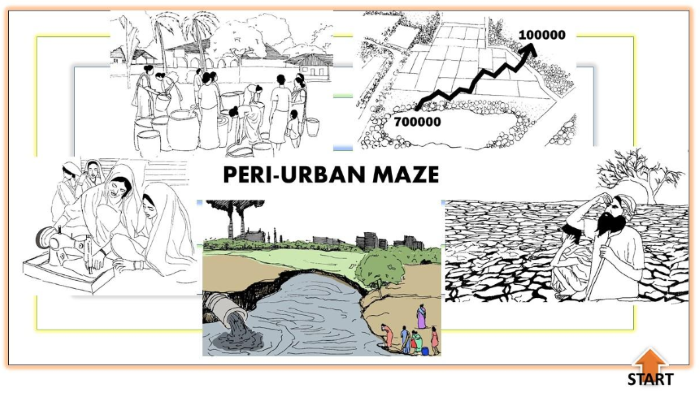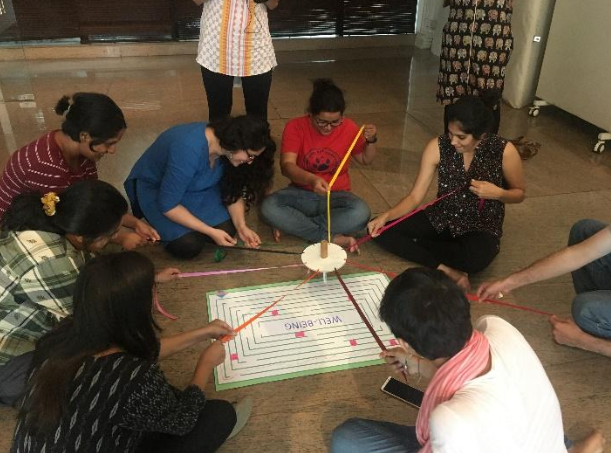Mazing through peri-urban Bangalore

Maitreyi Koduganti from the Indian Institute for Human Settlements (IIHS) gives an account of a game that she developed, with the support of an ASSAR Small Opportunities Grant, to help people gain better insight into the complexities of living in peri-urban Bangalore.
During one of our long afternoon meetings in August 2017, my lead exclaimed, "Why don’t you develop a game? We have a repository of data and findings – pick up something of your interest." That seemed like an interesting idea at the time but I wondered how a game of 30 minutes would inform people about what we had found. Without thinking much, I parked this cloud of thought and proceeded with my daily outputs.
In September 2017, the call for ASSAR RiU-Small Opportunities Grants (SOG) was announced. The thought of developing a game flashed once again, and this time to stay. I submitted my proposal with an excitement to explore my gaming skills. The D-day came in the early months of 2018, and I was given a grant to develop a participatory game based on ongoing studies under ASSAR peri-urban Bangalore.

The Peri-Urban Maze. (Illustration by Nooreen Fatima, UFP 2017-18)
Tinkering with game mechanics
Back then, I had little understanding that developing a game is not child’s play. I assumed that developing this game would be like getting some puzzles in place, developing some checkers and getting people to play! This misconception ended quite soon when my guide Bettina Koelle, from the Red Cross Red Crescent Climate Centre, shared a ‘game concept’ template in April – the start of my journey of ‘mazing through peri-urban Bangalore'.
When I went through this template, I knew nothing, except for the background to the game. I came across a new term, ‘game mechanics'. The last time I remember looking at mechanics was in my Physics class, when I was learning Fluid Mechanics!
I learned more about this new concept when I visited Cape Town in June 2018 to attend the ASSAR Annual Meeting and Adaptation Futures 2018 conference. It was during the cheese and wine function that I officially met my guide. It was an ecstatic moment! The first thing I asked her was: "Bettina, what is a game mechanic?" She looked at me and smiled: "The rules of the game, of course!" She explained: "When you are designing a game, you need to ask yourselves a lot of questions: 'How long do I want the game to take?' 'Who is my target audience?' 'What’s the central theme?' 'Are there other games out there like this one already?' 'How many players will play at a time?' 'What equipment do I need (board, cards, coins, etc.)?' And so on. This defines a game mechanic."
It sounded so straightforward and simple when she explained this, whereas I had compared game mechanics to rocket science! When I attended Bettina's Masterclass on the 22nd of June, I perfectly understood what I had to do! When I saw her conduct the games, she sailed through the facilitation so easily! She simplified complex problems through a mere 30-minute game. That’s when I realised, of course games can achieve great things! First of all, they help players develop an understanding of different perspectives, because they sometimes integrate elements of role play, or require players to really understand the strategy of their opponents or team members. Games also provide a certain distance from the real world, allowing players to experiment with different strategies, where the costs of failure are low (unless they are very sore losers).
I returned to India and spent the next few months developing the game and its components. Bettina has been extremely generous with her time – she guided me through the whole process of conceptualisation and development. I must also thank Zoom (a video communications platform) for making me feel like Bettina was sitting right next to me. Sometimes online platforms of communication are a real boon!
What is the game all about?
The game is called 'The Peri-urban Maze'. It requires eight players and the objective is simple: all players have to reach the centre of the maze. The centre of the maze represents wellbeing – denoting prosperity, positive physical and mental health, and sustainable thriving conditions. While navigating through the maze using a string puller, the players encounter ‘unexpected events’ (derived from real-time events in peri-urban Bangalore). They can either cross the event or dodge it and find another way to reach the centre. To cross an event, they are required to follow the instructions given under each event. For example, if a player encounters a community borewell that has run dry, they have to drill a new borewell and pay four coins. If the player wishes to pass this event, they have to pay or otherwise find an alternate route. The players need to do all of this within 20 minutes. This game requires the following key equipment: a printed or drawn maze on an A0 sheet, a string puller with eight strings for players to navigate, and a deck of events cards.

String puller and the maze
Labyrinthing through the game
Once the mechanics were in place, I tested the game with my colleagues at work in the month of August. They had given me quite a few comments on how I could improvise and make it more fun while playing. So, I took the next three weeks to build on their responses and came up with an 'almost-final' version.

Piloting the game with colleagues
On 25 September 2018, I conducted a final demo of the game with a different audience, comprising of students, researchers and practitioners. The game went on for 30 minutes! And this time, it was a hit! The players were able to comprehend the messages that the game intended to convey.

Demo of the game
Feedback from participants
"I never realised peri-urban Bangalore is facing so many problems. And sometimes, as decision makers, we fail to understand why community members respond in a certain way to a certain problem. This game helped me to put myself in their shoes and think it through. It is an extremely thought-provoking game."
"The game helped me to understand that decisions taken by one member invariably have an impact on the other member. In real life, we often take decisions that suit us, not thinking much about the community we live in. This game taught me how to balance, communicate and reach the centre as a team!"
"When we face a risk, we have a price to pay. For example, if my community is flooded, I would either abandon the place, or reconstruct the space. The price boils down to money or time. That’s what this game taught me. If we had to cross an event, we had to pay a price. If we didn't want to cross, we had to take an alternate route, compromising on our time."
These reflections from the participants were precisely what the game intended to convey. With multiple processes at play in peri-urban Bangalore, it becomes imperative to identify the drivers of vulnerability that shape the choices and behaviour of these ‘transitional’ communities. To offer policy recommendations and management options, it is important for decision makers to perceive these complexities while offering solutions that ensure the sustainability of these ‘urban fringes’.
Personally, I feel that this game has enabled its players to explore the complexity of peri-urban systems, helped them to demystify failure and, of course, contemplate the necessity for collaboration in the process of decision making. With this deep reflection, I must add that the process of developing this game has been one my most exciting ventures. Not only did I learn the art of gaming from our very own expert Bettina, but I have learnt the importance of simple, yet powerful, forms of communication. As next steps, we intend to dovetail this game as a part of our existing capacity building channels, for a wider audience to appreciate this process.
A famous gamer once said, "A game is an excuse for a good debrief. While a good debrief is an excuse for having an effective team building." This is my takeaway from this journey!
Maitreyi Koduganti Venkata works as a researcher with the climate team at the Indian Institute for Human Settlements (IIHS) in Bangalore, India. Her core areas of focus are Research-into-Use and Transformative Scenario Planning within the ASSAR Project.
Photos by Nilakshi Chatterjee and Maitreyi Koduganti